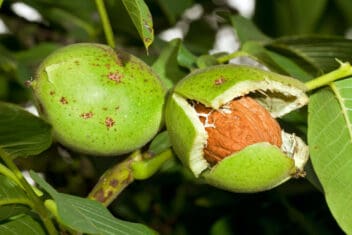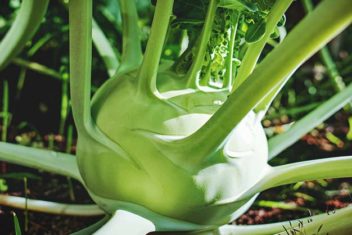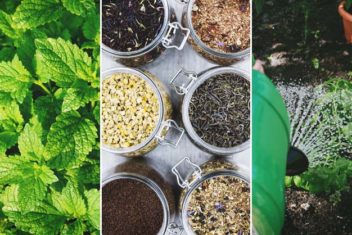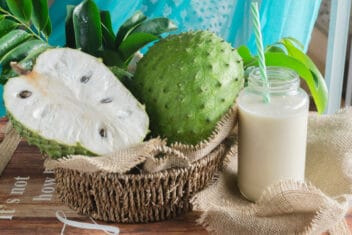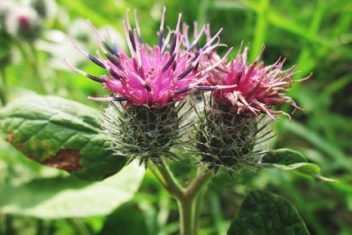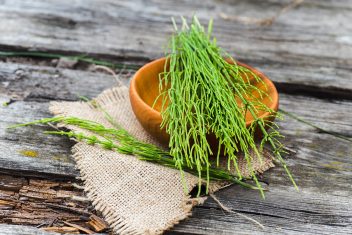What looks like a potato, grows like Jerusalem artichoke, and tastes like a fruit? Yakon! If you’ve never tried growing this unique tuber, it’s time you did.
Sometimes called ground pear, earth apple, and Bolivian sun root, yacon has a flavor you wouldn’t expect from a tuber. It tastes like a mix between watermelon, apples and celery with a little pear thrown in. The texture is like a water chestnut.
Yacon is said to be good for the digestive system, immune system and is a sweet treat suitable for diabetics. If you’re excited to grow this wonderful tuber, let’s get going.
What is Yacon?
Yacon (Smallanthus sonchifolius) is a perennial tuber from South America. It’s one of those fantastic plants that keeps on giving. It looks a little like small sunflowers amongst a bed of green leaves.
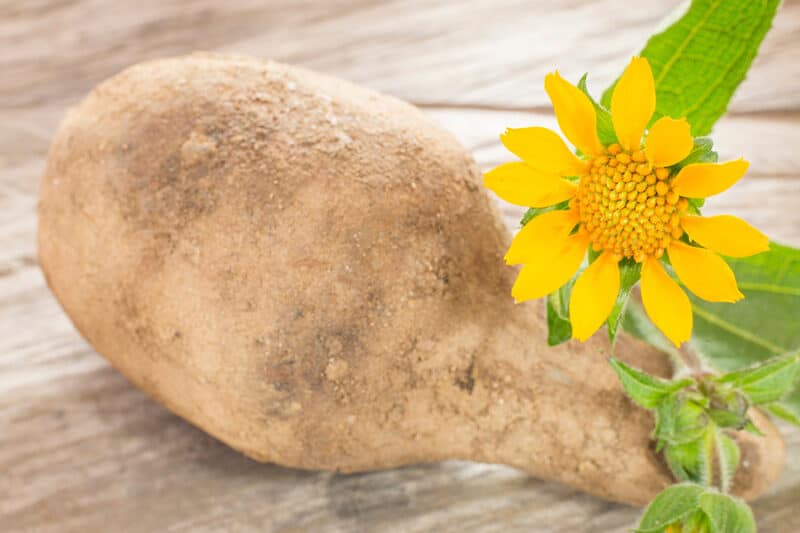
The name comes from the Incan phrase for “water root,” which tells you a bit about how moist this veggie is.
The tubers come in a range of colors, including red, purple, yellow, and pink. Outside of South America, white is most common.
It can grow up to six feet tall in the right conditions, but it’s the roots underground that are most interesting. Yacon has two sets of tubers. One set is close to the surface. These small tubers are propagation roots. The larger, deeper tubers are the energy storage parts of the plant.
Varieties of Yacon
Yacon isn’t easy to find, but if you manage to find a supplier, there are a few varieties that really stand out.
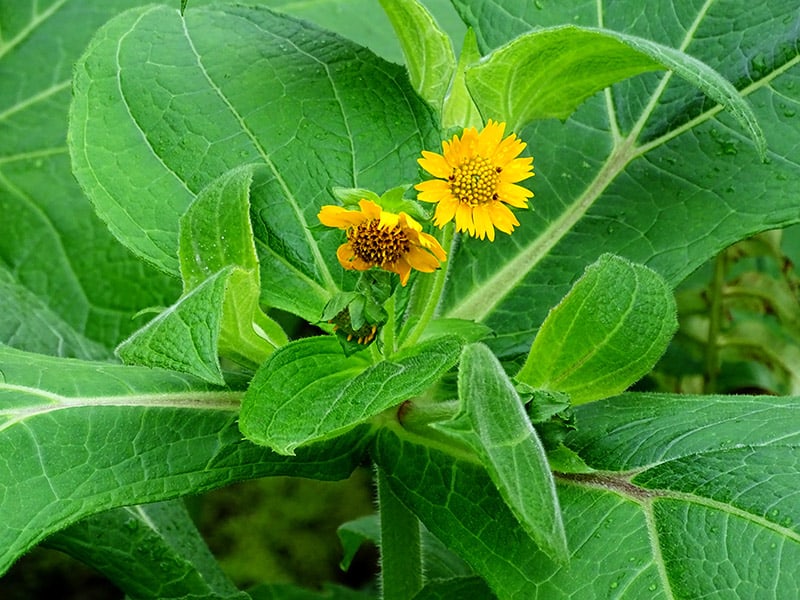
Bekya
This is one of the less sweet varieties but has a high yield. It’s better cooked and is less likely to crack in wet soil than some other types. Compared to other yacon, ‘bekya’ is an early variety.
Bogachiel
A great variety for a first-timer, ‘bogachiel’ is a high yielding plant. It has tan skin that turns darker red after harvest, with yellow flesh inside. This is a sweet tuber and the flowers are plentiful.
Late Red
‘Late red’ has serrated leaves with red stems. The tubers are tan with orange flesh. Late red is quite compact..
New Zealand
This variety has furry red leaves and stems. It produces a large crop for both eating and replanting.
Sol Duc
Another great variety for first time yacon growers. This is an exceptionally sweet variety that is red at first and continues to grow darker, almost black after harvest. ‘Sol Duc’ was introduced in 2019 and is a cross between ‘Morado’ and ‘Quinault.’
Other varieties include:
- ‘Kalaloch’ – early with a moderate harvest.
- ‘Morado’ – early with a high yield.
- ‘Quinault’ – early with a moderate harvest.
- ‘Rojo’ – Late with a moderate harvest.
- ‘Rose’ – Late with a moderate harvest.
- ‘Cajamarca’ – varies with a moderate harvest.
How to Plant Yacon
Yacon grows well in zones 5 to 8. It will grow in cooler climates, but the yield will be smaller. You’ll also need to start your plant early inside in the spring since they need 6 or 7 months to mature.
Yacon needs sun, but prefers to be sheltered from strong wind.
Dig well-rotted manure into loamy, well-draining soil to prep for planting. Yacon will rot if it gets wet feet. Aim for a pH of 6-6.5.
When to Plant
The best time to plant your yacon is at the same time as your tomatoes. This is generally when nighttime temperatures are consistently above 50°F. Make sure the danger of frost is over.
Container Planting
Growing yacon in containers is smart – you’ll realize how much sense it makes around harvest time. Yacon tubers can be brittle and prone to snapping when dug from the ground. When you harvest from a container, you usually avoid this kind of damage.
Plant a sprouted rhizome in a large pot, at least 5 gallons. Fill with good quality potting mix with enough nutrients to provide for a couple of weeks’ growth. Plant about 6 inches deep and water lightly, just enough to keep the soil moist.
Feed with liquid fertilizer once a month and don’t allow the soil to dry out.
Planting Tubers
Obtain a rhizome from a friend or buy them from a nursery. Those that sell yacon ship the sprouted rhizomes only at certain times of the year, so plan ahead. Once you buy your first lot, you won’t need to buy it again. Yacon provides you with both food and tubers to plant the following season.
Dig and loosen the soil to a depth and width of 15 inches. This is to make sure the yacon can spread out easily underground. Work in aged manure. Yacon grows swiftly and requires a lot of nutrients.
Place the tuber in a hole about 3 inches deep with the sprout sticking up. Cover with soil and firm down slightly. Water well initially to settle the plant and make sure it doesn’t dry out.
Yacon can grow up to 6 feet, so purchase a short variety if you live in an area with high winds. This is important because you don’t want to see your fully grown yacon plant snap off on a windy day.
Planting Seed
It’s technically possible to succeed at growing yacon from seed, but the germination rate is extremely low and not worth the time and effort. Leave the seeds to the professionals.
Spacing
Yacon grow tall. Some reach over 6 feet and others to around 4 feet. Plant the tubers 32 inches apart and the rows 24 inches apart. This is big spacing, but as the plants grow, they become crowded easily.
Caring for Yacon
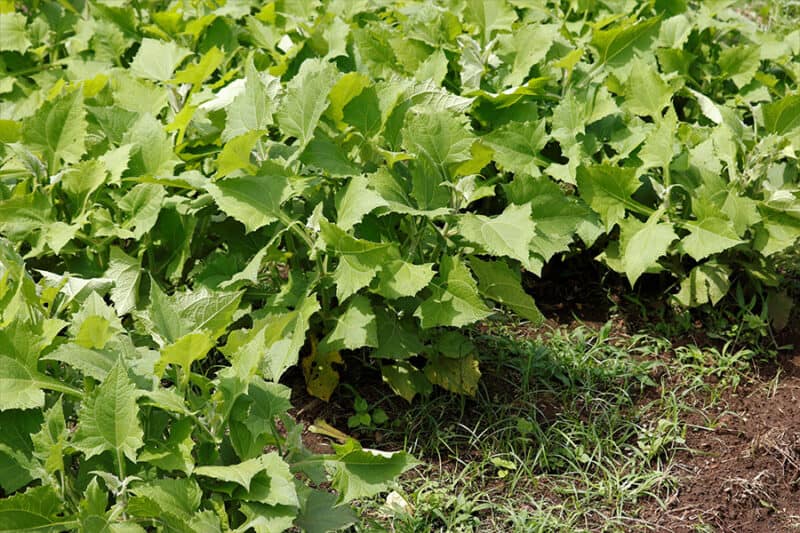
Yacon isn’t too demanding, but you do need to make sure it gets enough food and water.
Fertilizer
Yacon craves potassium so use potassium-rich, organic fertilizer. I use wood ash or liquid seaweed fertilizer. Feed once a month. Avoid fertilizers high in nitrogen or you may end up with a lot of plant above the soil and few tubers.
Water
The yacon rhizome holds a lot of water – this is a thirsty plant! Don’t allow the soil to dry out. Keep it moist, but not saturated. I water deeply once a week unless the weather gets hot. Then I’ll water twice a week.
Companion Planting for Yacon
Yacon grows well with:
- Radish
- Turnips
- Beans
- Beets
- Peas
- Spinach
- French Beans
- Zucchini
Common Problems and Solutions for Growing Yacon
Yacon is susceptible to a few pests and diseases, but is generally robust.
Slugs
Slugs love yacon leaves when they are young. Use slug pellets or your favorite control method. As yacon grows, the slugs lose interest.
Sunflower Root Moth
The silvery adult moth lays her eggs on the foliage of yacon. Then, the larvae burrow into the stem, eating their way down to the roots.
Pheromone traps are an effective way to manage populations. Tachinidae parasitic wasps are also a good deterrent. If that doesn’t tackle the problem, use Bacillus thuringiensis.
Cucumber Mosaic Virus
If your plant’s leaves become distorted and yellow, you may have cucumber mosaic virus. This disease causes stunted growth, meaning a low yield. There is no cure and you should pull and destroy the plants to avoid spreading the disease.
It’s spread by aphids, so keeping them out of your garden is essential. It’s too late to stop them from spreading the disease once they land on your plant, so prevention is key.
Aster Yellows
Aster yellows turns plants yellow and causes them to become stunted. Flowers will be malformed and small. Once aster yellows is confirmed, you must remove the plant. It can be composted as this virus can’t survive once the plant is dead.
Harvesting and Storing Yacon
There are various ways to decide when yacon is ready to harvest. You can wait for the tops to die back due to frost or in areas that are frost-free, harvest in late fall when temperatures begin to drop.
If you go this route, however, you won’t be able to eat the leaves.
Instead, I find that as long as the yacon has been growing for seven months, I can harvest the roots. When you harvest yacon, you will be harvesting the larger roots to eat and smaller tubers to use as your seeds for next season.
To harvest, cut the stems back to around four to six inches and loosen the soil around the yacon stems. Dig about 24 inches around the base. Remember, yacon are prolific growers and you don’t want to cut through the tubers.
Try to loosen and dislodge the root clump. Use your hands to remove the dirt. Carefully, lift the entire clump out in one piece if you can. Be warned, this may be heavy.
You should see small purple tubers at the top of the clump and bigger yellow, orange or tan tubers at the bottom. Cut or snap off the bigger tubers.
Lay these in the sun for a couple of days. Make sure they are protected from rain, moisture, and insects. Leaving them in the sun will add to their sweetness.
The small purple tubers at the crown are the starters for next season. You can put them back in the hole or separate them to start new plants.
Storage
Store the tubers for eating in a cardboard box or mesh bag at about 40ºF. They should stay fresh for months. If any are damaged or broken during the harvesting process, eat those immediately. Damaged yacon doesn’t store well, much like potatoes.
Check weekly to make sure none of them are going moldy or soft.
Store the small purple tubers in one big clump in a cardboard box and cover in peat moss. These are your yacon for planting out next season.
Using Yacon
Yacon is so versatile. You can eat it raw like fruit – just peel and dig in. You will be surprised how much water is stored in the tuber and the unique flavor is such a treat.
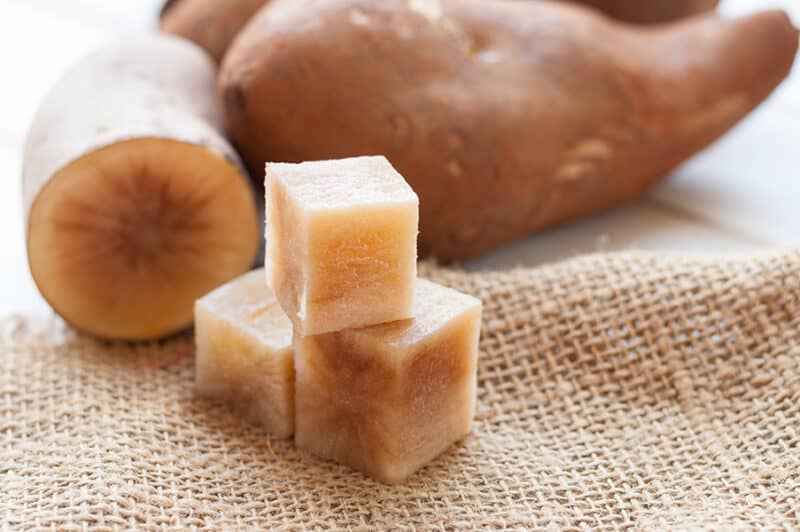
Use yacon in soups, stews, and casseroles. You can pickle and ferment them. Juice the tubers and mix them with either apple or lemon juice.
In fact, you can use it anywhere you’d use an apple: sliced in green salads, chopped in fruit salad, baked… use your imagination.
Eat the leaves, too. They can be used like cabbage leaves, steamed and stuffed or mixed into soups.
Yacon is one of the most prolific producers in a garden. Like potatoes, it’s a cash crop that stores well and provides it’s own tubers for replanting next season. This makes it perfect for any garden, but especially for survival gardens.

